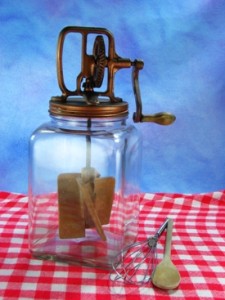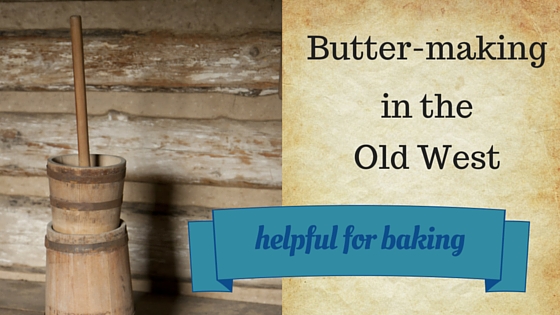Butter-making in the Old West
Butter-making in the Old West
.
Butter was not essential to baking, and still is not. But butter tastes good and has superior “mouth feel”. It’s flavorful and delicious. Fat serves important purposes in bread, biscuits, pies, and cookies.
.
Lard
.
In the “Old West” days, whenever a hog was butchered, economical folk would render every bit of fat from the animal for use in candle-making, soap-making, and the highly valued leaf lard (the soft fat from around the loin and kidneys of the pig). When properly rendered, leaf lard is a premium baking ingredient, odorless (doesn’t smelly “porky” at all), and super-spreadable at room-temperature).
Our great-grandmothers baked regularly with lard to make the flakiest of pie crusts, tender yeast bread, and light-as-air biscuits. But hogs were typically butchered just once a year, in the late autumn when cooler temperatures decreased spoilage of the large quantities of meat, but not so cold to prevent this out-of-doors work from occurring.
.
Making Butter at Home
.

Antique Crockery Butter Churn
.
Butter-making in the Old West, in contrast, was a chore to accomplish about every-other-week. Milk pails were allowed to sit so the fat rose to the surface where it was skimmed off prior to consumption. Cream would be saved until a large enough quantity could be had for churning into butter.
.
I remember visiting my great-grandmother. Grandma kept a large enamel-coated flat-bottomed bowl filled with milk in her electric refrigerator. Why not buy it at the grocery store like my parents did?
I don’t remember her answer, but I do recall her disappointment I had no idea where butter came from, nor the simple housekeeping chore of putting foodstuffs to the best use possible. Why drink whole milk and go without butter for spreading on toast or whipping into a buttercream icing? In my own defense, I was less than 10 years of age and my exposure limited.
.
Churning butter isn’t as easy as they made it look at summer camp when we shook baby-food jars half-full of whipping cream.
Why?
.
The Magic of Butter-making
.
Butter “comes” out of the cream at about 55 to 65 degrees.
Try finding 60 degrees– ever— in an Arizona desert summer. Or struggling to raise the temperature of a wooden or crockery churn, even by aid of boiling water, in a Rocky Mountain winter.
.

Old engraved illustration of a woman churning butter.
.
“Let the cream be at the temperature of 55° to 60°, by a Fahrenheit thermometer; this is very important. If the weather be cold put boiling water into the churn for half an hour before you want to use it; when that is poured off strain in the cream through a butter cloth. When the butter is coming, which is easily ascertained by the sound, take off the lid, and with a small, flat board scrape down the sides of the churn, and do the same to the lid: this prevents waste.
When the butter is come the butter-milk is to be poured off and spring water put into the churn, and turned for two or three minutes; this is to be then poured away and fresh added, and again the handle turned for a minute or two. Should there be the least milkiness when this is poured from the churn, more must be put in.“
.
“The butter is then to be placed on a board or marble slab and salted to taste; then with a cream cloth, wrung out in spring water, press all the moisture from it. When dry and firm make it up into rolls with flat boards. The whole process should be completed in three-quarters of an hour. In hot weather pains must be taken to keep the applesauce from reaching too high a heat. If the dairy be not cool enough, keep the cream-pot in the coldest water you can get; make the butter early in the morning, and place cold water in the churn for a while before it is used.”
.
.
Freshly churned butter must also be separated from the buttermilk (good for all kinds of baking purposes, like buttermilk pancakes and buttermilk biscuits) then rinsed thoroughly and repeatedly until all traces of milk are removed. Otherwise, the butter will spoil quickly and end up inedible. Instructions and “receipts” of the time caution thorough repetitive rinsing.
.
Updated Inventions
.

Antique Butter Churn from the early 1900’s.
.
In the mid-nineteenth century, butter churns made a leap forward in technology with hand-crank, small-quantity glass jars (about 2 quarts) that could whip cream in one minute and make butter in two. Nathan Dazey, whose firm, the Dazey Churn & Manufacturing Company, produced small, beautiful churns made of glass. The expensive devices sold well. Hooray for labor-saving inventions!
The reason for small churns was that much of the butter made in homes was sweet or unsalted butter. Sweet butter was very perishable, especially before the days of modern refrigeration. Butter often absorbed odors and started to spoil, gaining an off taste within a day or two. To avoid spoilage and loss, housewives churned butter in small quantities that could be used rapidly.
I can’t imagine the hard work of churning butter roughly 25 times per year… on top of milking the cow(s), washing the churn, keeping the milk pails clean, and trying to keep the diary products as fresh as possible in the spring house or icebox.
Dairy products, including butter, often took on the flavors of plants the cows ate, burning resulting butter and milk bitter. No wonder so many ditties and poems were common in the 19th century to help the chore move along as well as teach caution in preparing sweet butter. (Remember “..make her bitter batter better…”?)
.
Applying History to Fiction
.
While researching and writing my recent title, The Drifter’s Proposal, I determined my characters (Adaline Whipple and Whipple Bakery) would purchase butter ready-made from neighboring farmers. Whipple Bakery purchased flour ground at a local mill and milk from a dairyman. My characters began baking before dawn and worked ’til dark (especially in December when the book is set).
Who had time to churn the quantities of butter they’d require, simply to bake specific recipes that most required butter? Not my characters– and not me! I believe I’ll bake, instead of churn.
.
Up next: a flaky, no-fail pie crust recipe (using butter) that’s more than 100 years old.
.
Related Articles
.
.
.
Updated January 2021
Copyright © 2015 Kristin Holt LC
Butter-making in the Old West























Excellent blog Kristin. Hope you don’t mind, but I saved this for my research. I have a heroine in 1860 who writes a column for housewives and churns her own butter. She is not old west. In fact Genevieve (named for my mother) lives in Washington City (DC to us these days).
I also own a RedWing pottery butter churn that my own grandmother used until 1935 when my grandparents weighed the savings and bought an electric refirdgerator. Wish I had that too!!
Love your articles and information.
Of course you can save this blog post, Tracie. I’m happy you found it useful. I’m amazed at all the work our forebears accomplished week after week and found necessary just for economical survival. I’m ultra fond of reading about the 19th century, but am relieved to be a modern woman. Thanks for commenting!